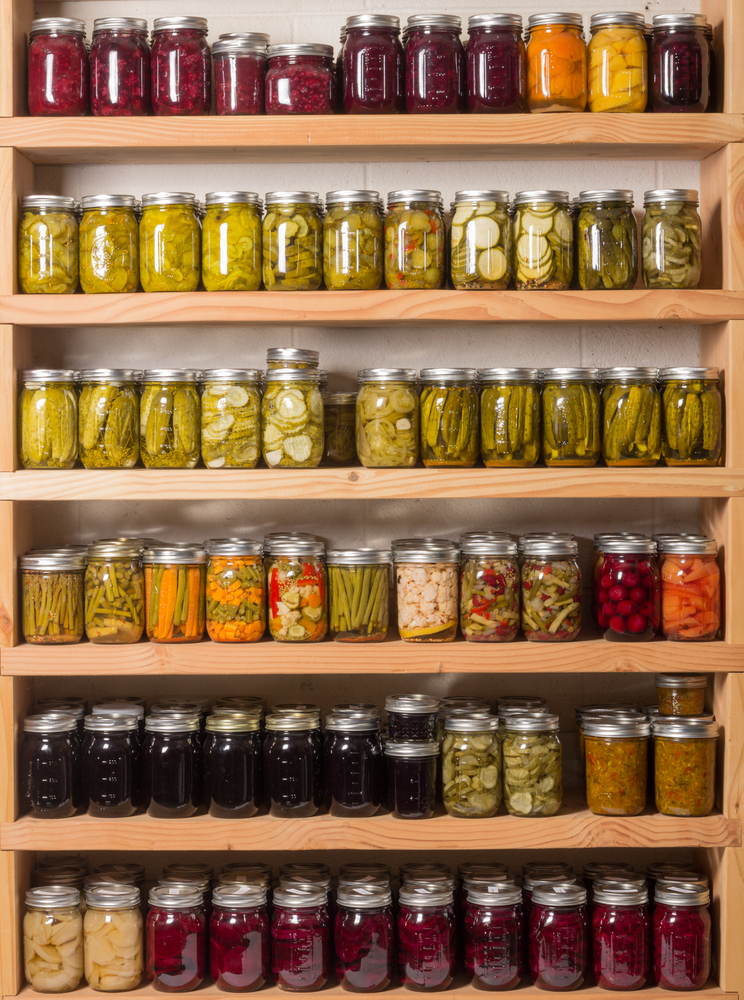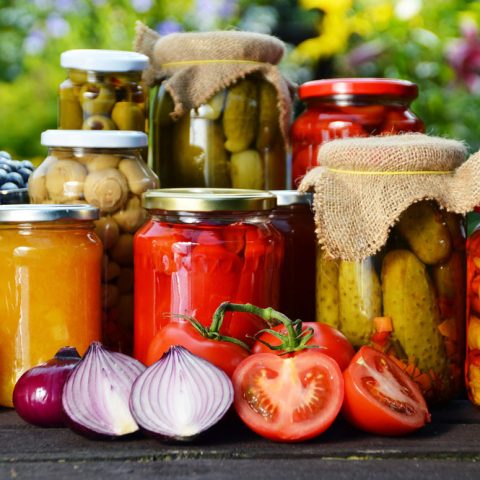Yes! You Can Can!
More than just an autumn event, for gardeners and fresh fruit growers, canning and preserving can be an ongoing activity as different crops ripen to that plucky readiness.
If it’s not harvest time, or you don’t have a garden, you can still save money by preserving food. Just watch for sales on in-season produce at your local grocer and preserve those. Alternately, you can support local growers by frequenting your farmers market for fresh produce to preserve.
From strawberry preserves in spring to root crops like radishes and beets, there are garden goodies you can preserve throughout the seasons to lock in that garden fresh flavor and nutrients.
There are few things more gratifying and satisfying to a gardener than a pantry full of garden fresh canned food. No matter if you’re growing your own food, purchasing fresh produce from the Farmer’s Market, or stocking up on sales at your local grocer, it’s great to be able to preserve fresh food.
A well stocked pantry of garden fresh produce is salve to the gardener’s soul.
~GardensAll.com

Storing Food
Squirrels know to stash food away for winter. Many humans have forgotten how. We haven’t needed to. But, in uncertain times and in an era of health crises from processed, preservative and additive laden foods… it’s time to return to nature and the garden.
We can grow, preserve, conserve and enjoy!
Home Preserves Make Great Gifts
When we’ve received canned garden gifts—especially in winter—they’re the best! The homemade salsa from my sister-in-law, and the canned tomatoes and vegetable soup from my mother… those carefully preserved treasures from the garden are always the best!
Fresh canned vegetables from the garden are like summer sunshine in a jar.
~GardensAll.com

Good Resources and Canning and Preserving Food
Jars for Canning
And if you need to stock up on canning jars or lids (we always need extras), it’s easy to have these delivered right to your door. These also look cool: Ball Wide-Mouth Plastic Storage Caps. Have you tried them? We also like the Tattler reusable lids (and rings).
Canning Equipment
If you’re just getting into the jar type preserving, here’s pretty much all you’ll need to get the hot water bath with a simple canning pot set. Or you might try this Amazon bestseller pressure cooker, for something more multi-functional.
Bags for Canning
Bags of dried vegetables, fruits and herbs are also a sight that brings gladness to a gardener’s heart. More than evidence of a labor of love, it’s a storehouse of nourishment and nature’s medicine, such as herbs for cold and flu.
We’re just getting into drying foods, starting with apples, having put it off for far too long. We’re starting with organic gala apples. While these are not from our garden because we don’t yet have an apple tree, that will come in the future. This year we’ve been testing a home dehydrator.
Many gardeners make great use the food preservation bag systems with vacuum seal options. One homesteader in the GardensAll community hangs her vacuum sealed bags in her pantry, thereby freeing up shelf space.
Dehydrators
Much of the summer, our food dehydrator is humming along all season. From early spring harvests to late summer through fall, we’re continuously drying garden goodies to preserve for food, medicine, teas and remedies.
If you’re using a dehydration system you like, we’d love to hear about your favorite.
Books on Canning and Preserving Food
For a comprehensive guide to everything canning, Canning for a New Generation: Bold, Fresh Flavors for the Modern Pantry by Liana Krissoff is a good book. And there’s also the best (how to) seller from the folks at Ball.
If you’re like us and try to avoid too much sugar, we highly recommend the book, Preserving with Pomona’s Pectin: The revolutionary Low-Sugar, High Flavor Method for Crafting and Canning Jams, Jellies, Conserves and More.
Apparently, the Pomona Pectin activates without sugar! If you’ve ever canned jams and jellies, you know that most canning recipes call for more sugar than fruit. Yikes!
More Good Books on Canning and Preserving
Root Cellaring – Natural Cold Storage of Fruits and Vegetables
Naturally Sweet Food in Jars: 100 Preserves Made with Coconut, Maple, Honey, and More by Marisa McClellan
Preserving with Pomona’s Pectin: The Revolutionary Low-Sugar, High-Flavor Method for Crafting and Canning Jams, Jellies, Conserves, and More by Allison Carroll Duffy
Healthier Canning for a Healthier Family
The one thing wrong with traditional canning and preserving is often how much sugar is used, especially in making fruit preserves.
Consider preserving fruits especially, with less — or no — sugar. Garden fresh foods are the healthiest possible. If we can preserve their natural goodness without loading in sugar in the preserving, canning and drying process, all the better! I know grandma did it, but…
We recommend trying your recipes with little to no sugar compared to what you typically find. Sugar is the number one cause of the majority of disease amongst developed nations.
Fortunately, today, we have more knowledge and resources for safe food preservation without sugar. So whenever possible, it’s best not to taint our nutritionally potent garden foods with a substance that science has found to be more addictive than cocaine!
We have more options today for healthier ways to preserve food.
Back to canning and preserving, when it comes to best canners, more people in the GardensAll Facebook community prefer water bath canning with the built in water spout for draining, like this one by Ball.
More Fruit and Less Sugar
Here’s the thing: grapes are one of the sweetest fruits. Naturally. And yet sugar is added to grape jellies and jams. But why? It’s not necessary. So many things we do are because it has always been done that way.
But if it doesn’t make sense, we don’t have to keep on doing it. One tablespoon of most grape jams contain over 1 tablespoon of sugar. What?! That means that each tablespoon of jam is basically flavored sugar.
We favor going for the richer flavor and greater health benefit of more fruit and less sugar.
Most jams contain over 1 tablespoon of sugar in a 1 tablespoon serving!!
Higher Fruit, Lower Sugar Store-Bought Fruit Spreads
If you run out of homemade jams, our favorite store-bought fruit spread with no sugar or sugar additives, is Fiordifrutta which you may find at Whole Foods or on Amazon, and Polaner All Fruit which you can find at most grocers.
Though Polaner does use additional fruit juice concentrate for sweetener, it still has fewer of the negative ingredients and only half the sugar of most jams and jellies.
But, back to canning:
Just because it’s always been done that way, doesn’t mean it always should be.
Naturally Sweet Preserves
Another avant-garde canning and preserving cookbook is Naturally Sweet Food in Jars: 100 Preserves Made with Coconut, Maple, Honey, and More by Marisa McClellan. Now Marisa still uses sweeteners, and while some sweeteners are certainly healthier than others, less added processed sugars in whatever form is best for health.
These are worth exploring over the traditional refined sugar laden preserving process, and especially if you’re health conscious. These also taste better in our opinion… more like the fruits than like fruit-flavored sugar.
Author Allison Carroll Duffy uses Pomona’s Pectin Universal Pectin for no or low sugar canning and preserving, and it’s available on Amazon.

The tradition of gardening and preserving bounty from the garden is priceless.
Gardening grows roots in your soul.
Canning and Preserving Okra
Canning Okra
INGREDIENTS:
- 1-1/2 pounds okra per quart
- Salt (optional)
- Water
INSTRUCTIONS:
- Wash and drain okra.
- Remove stem and blossom ends without cutting into pod.
- Leave whole or slice.
- Cover okra with cold water; boil 2 minutes.
- Pack hot okra into hot jars, leaving 1-inch headspace.
- Add 1/2 teaspoon salt to each pint jar,
- 1 tsp salt to each quart jar, if desired.
- Ladle boiling water over okra, leaving 1-inch headspace.
- Remove air bubbles.
- Adjust 2-piece caps.
- Process pints 25 minutes, quarts 40 minutes in a
steam-pressure canner.
Freezing Okra
INSTRUCTIONS:
- Select young tender pods when the seed is first formed.
- Wash in cold water, snip and cut into 2 to 4-inch lengths.
- Water blanch 3 minutes.
- Cool promptly by dripping in ice water bath, drain and package, leaving 1/2-inch
headspace. - Seal and freeze.
The subtle and potent flavor of foods from nature is rich and vital. The more we get used to eating food in its natural state the less we need and want added junk and the healthier we become.
Most processed foods have two predominant flavors: sweet or salty.
Yet nothing tastes as sweet as the nourishing fresh dried fruits of your labor, whether it’s an apple from your own apple tree, blueberries from your bush or strawberry plants, those luscious bites are a taste of heaven.
And nothing is as mouthwatering savory and zesty as tomatoes or herbs from your garden. Nature’s bounty is rich, aromatic, delicious and nutritious. Homegrown food stores are like money in the bank, so enjoy canning and preserving the bounty of your harvests!
If….
“Gardening is like printing money.”
~Ron Finley, “Guerrilla Gardener”
Then…
Homegrown canned food lining your shelves is like money in the bank!
So let’s be sure to make lots of deposits this year!
How to Preserve, Can, Freeze and Dry Your Garden Harvest
- Freezing Vegetables – here are some examples of less-commonly frozen foods:
- Canning –
- Pickling –
- Preserving Herbs
- Dehydrating Fruits and Vegetables
- Freeze Drying
Canning and Preserving Books
Here are a few bestselling books for more info and products on preserving and properly storing your garden bounty.
- Canning Recipes – this Amish canning book lists foods to can for every season listed in order of availability
- Jam, Jelly and Marmalade Cookbook – for your sweet tooth, this canning and preserving book has it all.
Wishing you great gardens, happy harvests and a well stocked pantry of garden fresh canned goods!
I’m LeAura Alderson, a garden, herb and plant enthusiast with a passion for discovering the many edible and medicinal benefits of the plants all around us, including the weeds! I’m a writer, editor and media publisher for our family of websites.
While I was certified in fitness and life coaching, I am NOT a health practitioner. However, I’m a lifelong health enthusiast, with a keen interest in healthy, organic foods and making home remedies and the content we share is from our own experience and usage as well as that extracted from scientific research so that you can explore further on your own.
Always seek the advice and guidance of your health practitioners first and foremost.
As a family we’re steadily expanding our gardening, experimentation and knowledge around all things gardening, edible landscaping, fresh organic foods and self sustainability with farming in our future. I also own and manage iCreateDaily.com, a site all about transformation through creation, and the power of positivity, optimism and mindset.




